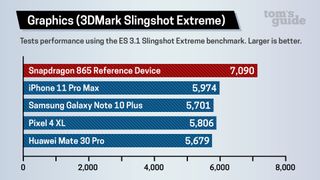Snapdragon 865 Benchmarks: Has the iPhone 11 met its match?
Based on Snapdragon 865 benchmark results, Qualcomm’s new processor closes the gap with Apple’s A13 Bionic.

Apple's A13 Bionic chip sets the standard for mobile processing performance, racing past Android phones in a majority of benchmark tests. But the competition is about to heat up when Qualcomm's Snapdragon 865 chipset starts appearing in the top Android phones in the first part of 2020.
We had the opportunity to test Qualcomm's latest mobile processor and found it narrows the once formidable gap the iPhone once enjoyed over its Android competition in a leading benchmark. The Snapdragon 865 also set the pace on one graphics benchmark — not surprising, given the graphics improvements Qualcomm is touting for this chipset — though the Apple's A13 chip continues to top all rivals in our real-world video editing test.
The bottom line? When the first Snapdragon 865-powered phones start appearing early next year, likely led by Samsung's Galaxy S11, the performance edge that Apple's phones have enjoyed could be severely diminished. At least, until the iPhone 12 and its faster processor debut later in the fall.
Here's what we saw from the Snapdragon 865 in our time with the device.
About the Snapdragon 865
First, though, you should get acquainted with the Snapdragon 865, the next-generation of Qualcomm's top-of-the-line system-on-chip which the company unveiled earlier this month. Several leading Android phone makers, including Xiaomi, Motorola and Oppo plan to release phones powered by the Snapdragon 865 in 2020. But if history is any guide, the first phone out of the gate will be the latest flagship from Samsung. The Galaxy S11 is rumored to be making its debut on Feb. 18, so that could be our first chance to see the Snapdragon 865 in the wild.

In unveiling its new chipset, Qualcomm focused on the Snapdragon 865's improved image processor, artificial intelligence and gaming capabilities — not really things that we can put to test during the limited window of benchmarking time we had with Qualcomm's 865-powered reference device.
But there are promised performance improvements, too — Qualcomm says the Kryo 585 CPU featured on the Snapdragon 865 offers a 25% boost to performance over the Snapdragon 855 while improving power efficiency by 25%. On the graphics front, Qualcomm is aiming to speed up graphics rendering by 25% over last year's processor, with improvements to the Adreno 650 GPU.
Sign up to get the BEST of Tom’s Guide direct to your inbox.
Upgrade your life with a daily dose of the biggest tech news, lifestyle hacks and our curated analysis. Be the first to know about cutting-edge gadgets and the hottest deals.
How we tested the Snapdragon 865
Qualcomm gave us a reference device running on a Snapdragon 865 processor to conduct our tests. The 5.9-inch device came with 12GB of RAM and 128GB of storage. Its CPU featured four performance cores based on Arm's Cortex-A77, and four efficiency cores based on the Cortex A-55.
When conducting our benchmark tests, we kept the reference device in performance mode — a setting that prioritizes performance over battery life. Phone makers can adjust that setting in their shipping devices, which is why you'll see some variance in benchmarking numbers, even from Android phones that have the same chipset and comparable RAM. So the numbers we saw from our Snapdragon 865 testing may be quite different from what actual shipping phones wind up producing. Still, this kind of testing can give us an idea of what we're likely to see from those Snapdragon 865-powered devices.
Snapdragon 865 Geekbench 5: A close multicore result
The A13 processor introduced with Apple's iPhone 11 lineup usually laps the field in Geekbench 5, which measures overall performance. The A13 inside the iPhone 11 Pro Max still produces one of the best results we've seen on Geekbench 5, but the Snapdragon 865 isn't that far behind.
| Phone (Processor) | Score (Larger numbers are better) |
| Snapdragon 865 Reference device | 3,463 |
| iPhone 11 Pro Max (A13 Bionic) | 3,517 |
| Galaxy Note 10 (Snapdragon 855) | 2,640 |
| Pixel 4 XL (Snapdragon 855) | 2,582 |
| OnePlus 7T (Snapdragon 855+) | 2,759 |
| Huawei Mate 30 Pro (Kirin 990) | 2,881 |
Running Geekbench 5 multiple times on our Snapdragon 865-powered reference device, we recorded an average multicore score of 3,463. That's not far behind the iPhone 11 Pro Max's 3,517 result when we tested Apple's phone earlier this year. That's less than a 2% difference between the two processing platforms.
As you might imagine, it's also a big gain over what Qualcomm's current chipset delivers. The OnePlus 7T, aided by 8GB of RAM and a slightly faster Snapdragon 855 Plus processing platform, posted a score of 2,759 on Geekbench 5. That's a 26% gain for the Snapdragon 865. Comparing the new chip to the more conventional Snapdragon 855, the 865 improved on the multicore scores of the Galaxy Note 10 and Pixel 4 XL by 31% and 34%, respectively.

The A13 chip still dominates in single-core scores for Geekbench 5, though. While the Snapdragon 865's single-core result of 934 beat the Kirin 990-powered Huawei Mate 30 Pro by 21%, it was still well behind the iPhone 11 Pro Max's 1,334 result.
Snapdragon 865 graphics benchmarks
Phones using a Snapdragon 865 processor will easily handle whatever intensive graphics you throw at them. Whether the phone's benchmarking scores will top what the current iPhones can produce, though, depends on who's doing the counting.
| Phone (Processor) | 3DMark Sling Shot Extreme Score | GFX Aztec Ruins (Hiigh Tier) Offscreen Score |
| Snapdragon 865 Reference Device | 7,090 | 1,308 frames (20 fps) |
| iPhone 11 Pro Max (A13 Bionic) | 5,974 | 1,308 frames (20 fps) |
| Galaxy Note 10 Plus (Snapdragon 855) | 5,701 | 1,058 frames (16 fps) |
| Pixel 4 XL (Snapdragon 855) | 5,806 | 1,038 frames (16 fps) |
| Huawei Mate 30 Pro (Kirin 990) | 5,679 | 1,055 frames (16 fps) |
Running 3DMark's Sling Shot Extreme Open GL test for premium devices, the Snapdragon 865 is the champ, and by some measure. It scored 7,094 on that graphics test, well ahead of the iPhone 11 Pro Max's 5,974 result. The Snapdragon 865 also showed a 22% improvement over the Pixel 4 XL's 5,806 score — one of the better results turned in by a Snapdragon 855-powered phone on that particular benchmark.

On GFXBench's off-screen Aztec Ruins test for high-tier devices, the A13 processor still enjoys an edge. When we ran that test on the iPhone 11 Pro Max, it produced a score of 1,675 frames, or 25 fps. That's ahead of the Snapdragon 865's result of 1,308 frames (20 fps). But with Snapdragon 855-powered phones like the Galaxy Note 10 and Pixel 4 XL producing results ranging from 1,038 and 1,058 frames, the Snapdragon 865 should be a big improvement over previous Android flagships. Even the OnePlus 7T, which features a Snapdragon 855 Plus chipset that's geared for better graphic performance, produced a score of 1,169 frames (18 fps) that trailed the new Snapdragon 865.

Snapdragon 865 video conversion test: iPhone still tops
We didn't expect the Snapdragon 865 to beat the A13 processor in a test we run using Adobe Rush to transcode a 4K video to 1080p after applying an effect and transition. iPhones typically dominate this real-world test, with the iPhone 11 Pro Max setting the current pace by handling the task in 45 seconds. The Snapdragon 865 still lags behind, finishing the job in 1 minute, 54 seconds.
| Phone (Processor) | Time (Mins:Secs), shorter times are better |
| Snapdragon 865 Reference Device | 1:54 |
| iPhone 11 Pro Max (A13 Bionic) | 0:45 |
| Galaxy Note 10 Plus (Snapdragon 855) | 1:34 |
| Pixel 4 XL (Snapdragon 855) | 1:31 |
Surprisingly, that's slower than even the Snapdragon 855 phones we've tested, with the Pixel 4 XL transcoding the video in 1 minute, 31 seconds. We had to sideload Adobe Rush onto our Snapdragon 865 reference device to run the test, so it could mean that the app wasn't optimized to work at full efficiency on this new device.
It's possible we'll see better times on Snapdragon 865-powered phones that are released in the wild, though we'd still expect Apple's A13 to dominate Android phones on this test.
Snapdragon 865 browser performance: A nice jump
We typically don't include benchmarks like the JavaScript-based JetStream 1.1 in our reviews, but it's worth mentioning here just because it gives another illustration of how the Snapdragon 865 improves performance over previous Android flagships. Our Snapdragon 865 reference device posted a score of 123.46 in JetStream, a 31% improvement over the 93.91 score I recorded on my Pixel 4 XL.
The iPhone 11 Pro Max's JetStream score is far better than anything those Android phones produce, but that's more a reflection on how iOS handles JavaScript, so it's not a very valuable comparison.
Outlook
Benchmarks are just one piece of the puzzle when it comes to evaluating mobile processing platforms, especially given the other features Qualcomm is adding to the Snapdragon 865. For instance, the new chipset's support for 200-megapixel cameras and 8K video at 30 frames per second via its Spectra 480 chipset figures to dramatically enhance what you can do with the cameras on your next Android phone, though the benchmark tests we're able to run at this point won't reflect that. The same could be said for the promised improvements coming with the new AI Engine included with the Snapdragon 865.
However, the improvements we are seeing both in overall performance and graphics testing compare quite well to the best that Apple has to offer. Given these initial benchmarks, we can't wait to see the Snapdragon 865 land in a shipping smartphone and to fully compare how that new device measures up to the standard set by the iPhone 11 and its A13 processor.
Philip Michaels is a Managing Editor at Tom's Guide. He's been covering personal technology since 1999 and was in the building when Steve Jobs showed off the iPhone for the first time. He's been evaluating smartphones since that first iPhone debuted in 2007, and he's been following phone carriers and smartphone plans since 2015. He has strong opinions about Apple, the Oakland Athletics, old movies and proper butchery techniques. Follow him at @PhilipMichaels.
-
ChrisGX ...iPhone 11 Pro Max, it produced a score of 1,675 frames, or 25 fpsReply
That has not been correctly transposed in the Snapdragon 865 Graphics testing table. Incorrect data suggesting the same 1,308 frames (20 fps) result as the Snapdragon 865 is found in the table.

